Avoid infecting your system through fake "Agenzia entrate" emails
Phishing/ScamAlso Known As: Agenzia Entrate spam
Get free scan and check if your device is infected.
Remove it nowTo use full-featured product, you have to purchase a license for Combo Cleaner. Seven days free trial available. Combo Cleaner is owned and operated by RCS LT, the parent company of PCRisk.com.
What is the fake "Agenzia entrate" email?
"Agenzia entrate" refers to a spam campaign designed to proliferate malware. The term "spam campaign" is used to describe a large scale operation, during which thousands of deceptive emails are sent.
These messages are specifically disguised as email from Agenzia delle Entrate - the Italian Revenue Agency, a governmental agency that enforces financial code and collects taxes/revenue. In fact, the "Agenzia entrate" emails are fake and are in no way associated with the Italian Revenue Agency.
The purpose of these messages is to trick recipients into opening the attached file, which will infect their systems with the Ursnif Trojan.
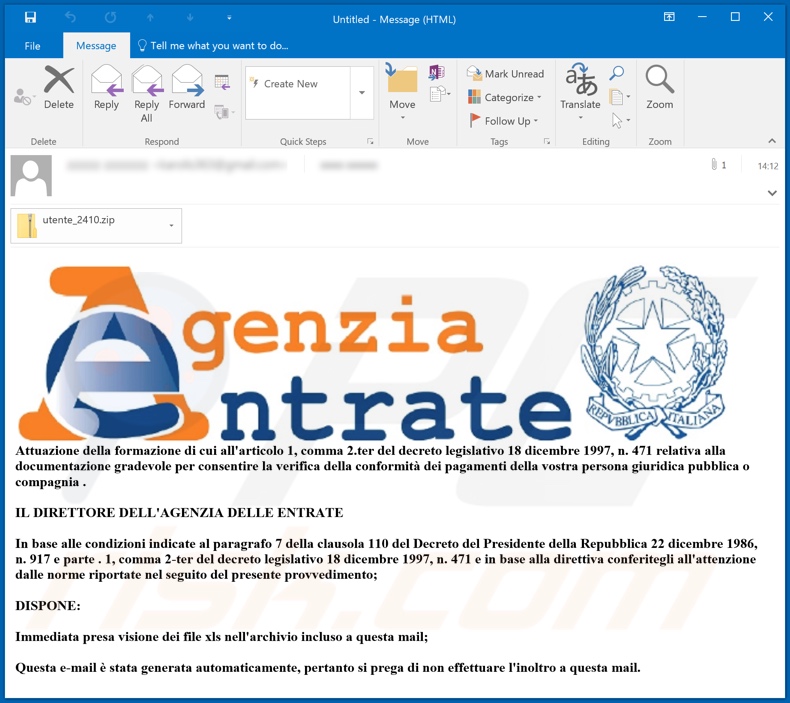
"Agenzia entrate" scam emails are untrusted and list various legislative decrees, articles and directions. According to a rough translation, these messages supposedly contain information relating to compliance verification for payments to/from the recipients' public legal entities or companies.
Recipients are urged to review the attached Excel spreadsheet ("utente_2410.xlsx" - the filename might vary) without delay. In fact, when this document is opened and macro commands (i.e. editing/content) are enabled, download/installation of Ursnif is triggered.
The main purpose of this Trojan is data theft, however, this is a multi-functional malware and hence it has additional capabilities unrelated to information stealing. Ursnif can extract and exfiltrate system information, browsing activity, account log-in credentials (i.e. usernames and passwords) from certain browsers and applications.
This Trojan also has the capability to record key strokes (keylogging). Cyber criminals typically target email, social networking, social media, messenger, online data storage, e-commerce, banking and other accounts. Through hijacked communication accounts, criminals can ask the owner's contacts for loans or proliferate malicious programs (by sharing infectious files).
Banking accounts and financial information (e.g. credit card details, etc.) are of particular interest - by stealing them, cyber criminals can make fraudulent transactions and online purchases. In summary, trusting fake "Agenzia entrate" emails can result in system infections, financial loss, serious privacy issues and even identity theft.
If it suspected/known that Ursnif (or other malware) has already infected the system, use an anti-virus program to eliminate it immediately.
| Name | Agenzia Entrate spam |
| Threat Type | Trojan, password-stealing virus, banking malware, spyware. |
| Hoax | .Emails are disguised as messages from Agenzia delle Entrate (Italian Revenue Agency). |
| Attachment(s) | utente_2410.xlsx (filenames might vary). |
| Symptoms | Trojans are designed to stealthily infiltrate the victim's computer and remain silent, and thus no particular symptoms are clearly visible on an infected machine. |
| Payload | Ursnif |
| Distribution methods | Infected email attachments, malicious online advertisements, social engineering, software 'cracks'. |
| Damage | Stolen passwords and banking information, identity theft, the victim's computer added to a botnet. |
| Malware Removal (Windows) |
To eliminate possible malware infections, scan your computer with legitimate antivirus software. Our security researchers recommend using Combo Cleaner. Download Combo CleanerTo use full-featured product, you have to purchase a license for Combo Cleaner. 7 days free trial available. Combo Cleaner is owned and operated by RCS LT, the parent company of PCRisk.com. |
"Wacker", "Covid-19 Health and Safety Plan", "Office had a contact with a coronavirus infected people" and "Request for quotation" are some examples of other malware-spreading spam campaigns.
The scam emails are usually disguised as "official", "important", "urgent", and so on, however, proliferation of malicious software is not the only purpose of spam campaigns - they are also used for phishing and other scams. Regardless of what these messages claim, offer, or request, they have just one purpose: to generate profit for the scammers/cyber criminals behind them.
How did "Agenzia entrate Email Virus" infect my computer?
Systems are infected through malicious files, which are distributed via spam campaigns. These files are attached to the emails or, alternatively, the messages contain download links of such content. Infectious files can be in a wide variety formats such as archives, executables, Microsoft Office and PDF documents, JavaScript, etc.
When they are executed, run or otherwise opened, the infection chain/process is initiated (i.e. malware download/installation is triggered). For example, Microsoft Office documents (e.g. Excel spreadsheets, such as those sent in "Agenzia entrate" spam campaigns) cause infections by executing malicious macro commands.
In MS Office versions released after 2010, users are asked to enable macros manually (i.e. to enable editing/content). Once this is done, the infection process begins, however, in older versions, macros are executed immediately the document is opened.
How to avoid installation of malware
You are strongly advised against opening suspicious or irrelevant emails, especially those with any attachments or links found in them. Use Microsoft Office versions released after 2010. These versions have "Protected View" mode, which prevents macros from being executed when a document is opened.
The use of spam campaigns is not the only malware proliferation method. Malicious programs are also spread via untrusted download channels (e.g. unofficial and free file-hosting websites, Peer-to-Peer sharing networks and other third party downloaders), illegal activation tools ("cracks") and fake updaters.
Therefore, only download from official/verified sources, and activate and update programs with tools/functions provided by legitimate developers. To ensure device and user safety, it is paramount to have a reputable anti-virus/anti-spyware suite installed and kept up to date.
Use this software to run regular system scans and to remove detected/potential threats. If you have already opened "Agenzia entrate Email Virus" attachment, we recommend running a scan with Combo Cleaner Antivirus for Windows to automatically eliminate infiltrated malware.
Text presented in the "Agenzia entrate" email message:
Attuazione della formazione di cui all'articolo 1, comma 2.ter del decreto legislativo 18 dicembre 1997, n. 471 relativa alla documentazione gradevole per consentire la verifica della conformità dei pagamenti della vostra persona giuridica pubblica o compagnia .
IL DIRETTORE DELL'AGENZIA DELLE ENTRATE
In base alle condizioni indicate al paragrafo 7 della clausola 110 del Decreto del Presidente della Repubblica 22 dicembre 1986, n. 917 e parte . 1, comma 2-ter del decreto legislativo 18 dicembre 1997, n. 471 e in base alla direttiva conferitegli all'attenzione dalle norme riportate nel seguito del presente provvedimento;
DISPONE:
Immediata presa visione dei file xls nell'archivio incluso a questa mail;
Questa e-mail è stata generata automaticamente, pertanto si prega di non effettuare l'inoltro a questa mail.
Malicious attachment distributed via "Agenzia entrate" spam campaign ("utente_2410.xlsx"):
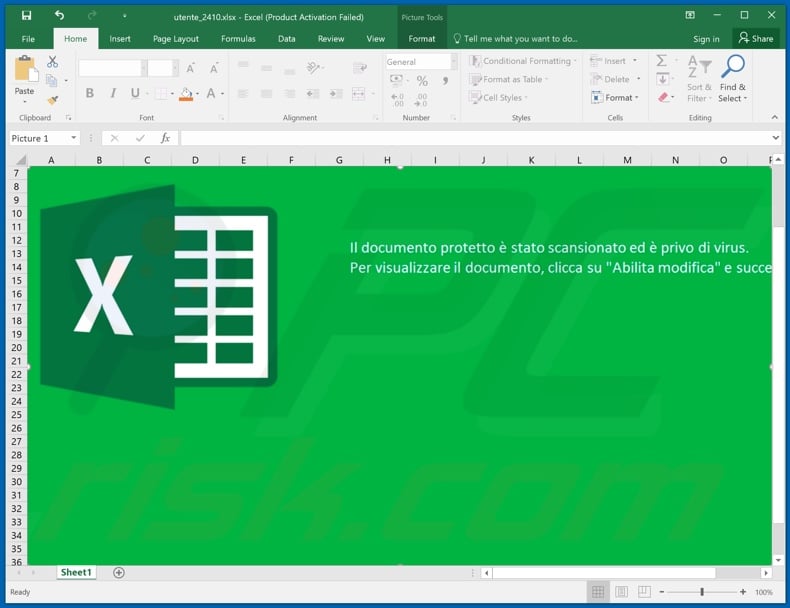
Another variant of "Agenzia Entrate" spam email used to spread an identical MS Excel document:
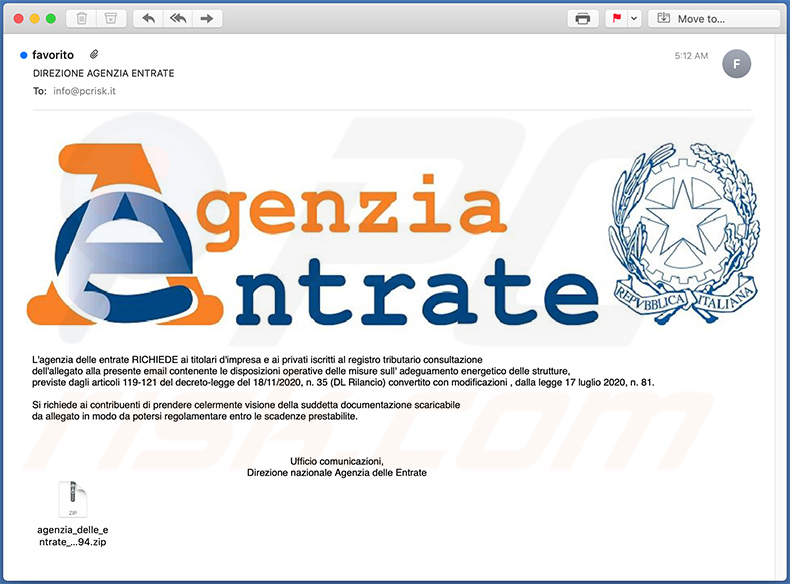
Text presented within:
Subject: DIREZIONE AGENZIA ENTRATE
L'agenzia delle entrate RICHIEDE ai titolari d'impresa e ai privati iscritti al registro tributario consultazione
dell'allegato alla presente email contenente le disposizioni operative delle misure sull' adeguamento energetico delle strutture,
previste dagli articoli 119-121 del decreto-legge del 18/11/2020, n. 35 (DL Rilancio) convertito con modificazioni , dalla legge 17 luglio 2020, n. 81.Si richiede ai contribuenti di prendere celermente visione della suddetta documentazione scaricabile
da allegato in modo da potersi regolamentare entro le scadenze prestabilite.Ufficio comunicazioni,
Direzione nazionale Agenzia delle Entrate
Yet another example of Agenzia Entrate spam email promoting a malicious MS Excel document:
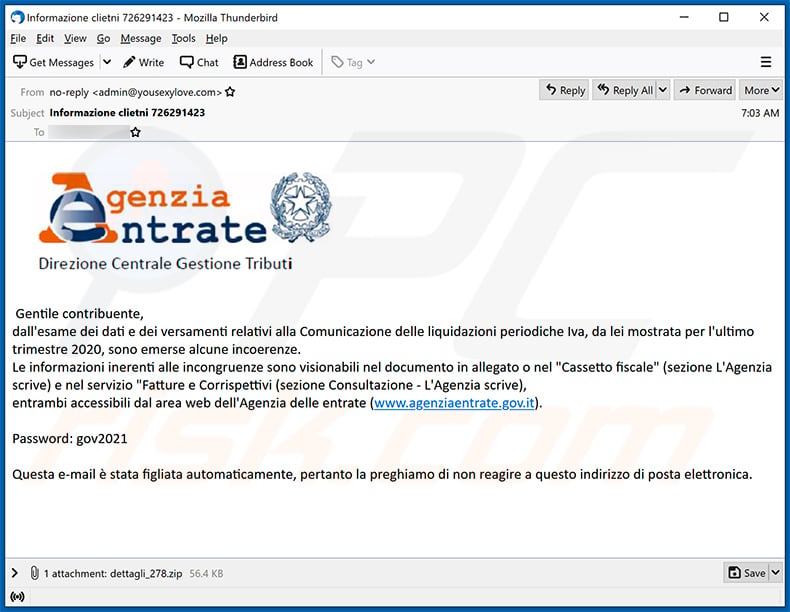
Text presented within:
Subject: Informazione clietni 726291423
Gentile contribuente,
dall'esame dei dati e dei versamenti relativi alla Comunicazione delle liquidazioni periodiche Iva, da lei mostrata per l'ultimo trimestre 2020, sono emerse alcune incoerenze.
Le informazioni inerenti alle incongruenze sono visionabili nel documento in allegato o nel "Cassetto fiscale" (sezione L'Agenzia scrive) e nel servizio "Fatture e Corrispettivi (sezione Consultazione - L'Agenzia scrive),
entrambi accessibili dal area web dell'Agenzia delle entrate (www.agenziaentrate.gov.it).
Password: gov2021
Questa e-mail è stata figliata automaticamente, pertanto la preghiamo di non reagire a questo indirizzo di posta elettronica.
Screenshot of the attached MS Excel doc:
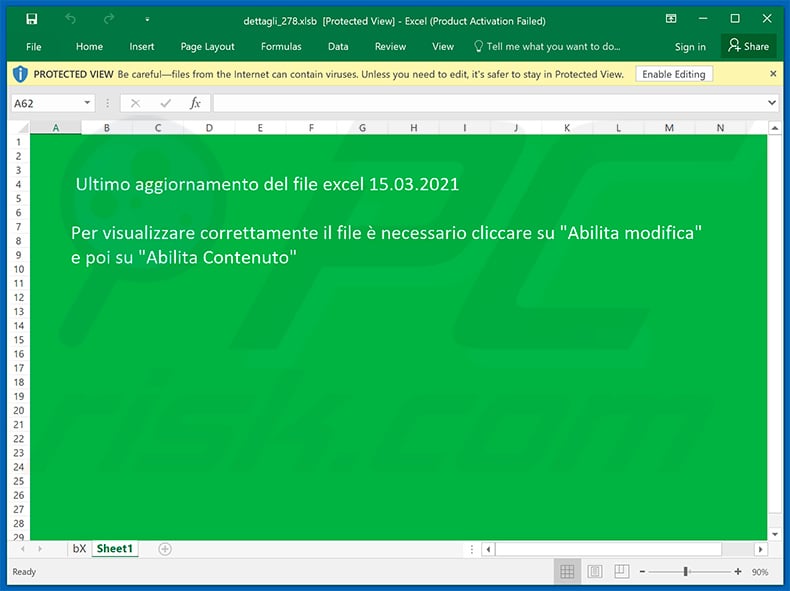
Instant automatic malware removal:
Manual threat removal might be a lengthy and complicated process that requires advanced IT skills. Combo Cleaner is a professional automatic malware removal tool that is recommended to get rid of malware. Download it by clicking the button below:
DOWNLOAD Combo CleanerBy downloading any software listed on this website you agree to our Privacy Policy and Terms of Use. To use full-featured product, you have to purchase a license for Combo Cleaner. 7 days free trial available. Combo Cleaner is owned and operated by RCS LT, the parent company of PCRisk.com.
Quick menu:
- What is Agenzia Entrate spam?
- Types of malicious emails.
- How to spot a malicious email?
- What to do if you fell for an email scam?
Types of malicious emails:
![]() Phishing Emails
Phishing Emails
Most commonly, cybercriminals use deceptive emails to trick Internet users into giving away their sensitive private information, for example, login information for various online services, email accounts, or online banking information.
Such attacks are called phishing. In a phishing attack, cybercriminals usually send an email message with some popular service logo (for example, Microsoft, DHL, Amazon, Netflix), create urgency (wrong shipping address, expired password, etc.), and place a link which they hope their potential victims will click on.
After clicking the link presented in such email message, victims are redirected to a fake website that looks identical or extremely similar to the original one. Victims are then asked to enter their password, credit card details, or some other information that gets stolen by cybercriminals.
![]() Emails with Malicious Attachments
Emails with Malicious Attachments
Another popular attack vector is email spam with malicious attachments that infect users' computers with malware. Malicious attachments usually carry trojans that are capable of stealing passwords, banking information, and other sensitive information.
In such attacks, cybercriminals' main goal is to trick their potential victims into opening an infected email attachment. To achieve this goal, email messages usually talk about recently received invoices, faxes, or voice messages.
If a potential victim falls for the lure and opens the attachment, their computers get infected, and cybercriminals can collect a lot of sensitive information.
While it's a more complicated method to steal personal information (spam filters and antivirus programs usually detect such attempts), if successful, cybercriminals can get a much wider array of data and can collect information for a long period of time.
![]() Sextortion Emails
Sextortion Emails
This is a type of phishing. In this case, users receive an email claiming that a cybercriminal could access the webcam of the potential victim and has a video recording of one's masturbation.
To get rid of the video, victims are asked to pay a ransom (usually using Bitcoin or another cryptocurrency). Nevertheless, all of these claims are false - users who receive such emails should ignore and delete them.
How to spot a malicious email?
While cyber criminals try to make their lure emails look trustworthy, here are some things that you should look for when trying to spot a phishing email:
- Check the sender's ("from") email address: Hover your mouse over the "from" address and check if it's legitimate. For example, if you received an email from Microsoft, be sure to check if the email address is @microsoft.com and not something suspicious like @m1crosoft.com, @microsfot.com, @account-security-noreply.com, etc.
- Check for generic greetings: If the greeting in the email is "Dear user", "Dear @youremail.com", "Dear valued customer", this should raise suspiciousness. Most commonly, companies call you by your name. Lack of this information could signal a phishing attempt.
- Check the links in the email: Hover your mouse over the link presented in the email, if the link that appears seems suspicious, don't click it. For example, if you received an email from Microsoft and the link in the email shows that it will go to firebasestorage.googleapis.com/v0... you shouldn't trust it. It's best not to click any links in the emails but to visit the company website that sent you the email in the first place.
- Don't blindly trust email attachments: Most commonly, legitimate companies will ask you to log in to their website and to view any documents there; if you received an email with an attachment, it's a good idea to scan it with an antivirus application. Infected email attachments are a common attack vector used by cybercriminals.
To minimise the risk of opening phishing and malicious emails we recommend using Combo Cleaner Antivirus for Windows.
Example of a spam email:

What to do if you fell for an email scam?
- If you clicked on a link in a phishing email and entered your password - be sure to change your password as soon as possible. Usually, cybercriminals collect stolen credentials and then sell them to other groups that use them for malicious purposes. If you change your password in a timely manner, there's a chance that criminals won't have enough time to do any damage.
- If you entered your credit card information - contact your bank as soon as possible and explain the situation. There's a good chance that you will need to cancel your compromised credit card and get a new one.
- If you see any signs of identity theft - you should immediately contact the Federal Trade Commission. This institution will collect information about your situation and create a personal recovery plan.
- If you opened a malicious attachment - your computer is probably infected, you should scan it with a reputable antivirus application. For this purpose, we recommend using Combo Cleaner Antivirus for Windows.
- Help other Internet users - report phishing emails to Anti-Phishing Working Group, FBI’s Internet Crime Complaint Center, National Fraud Information Center and U.S. Department of Justice.
Share:

Tomas Meskauskas
Expert security researcher, professional malware analyst
I am passionate about computer security and technology. I have an experience of over 10 years working in various companies related to computer technical issue solving and Internet security. I have been working as an author and editor for pcrisk.com since 2010. Follow me on Twitter and LinkedIn to stay informed about the latest online security threats.
PCrisk security portal is brought by a company RCS LT.
Joined forces of security researchers help educate computer users about the latest online security threats. More information about the company RCS LT.
Our malware removal guides are free. However, if you want to support us you can send us a donation.
DonatePCrisk security portal is brought by a company RCS LT.
Joined forces of security researchers help educate computer users about the latest online security threats. More information about the company RCS LT.
Our malware removal guides are free. However, if you want to support us you can send us a donation.
Donate
▼ Show Discussion